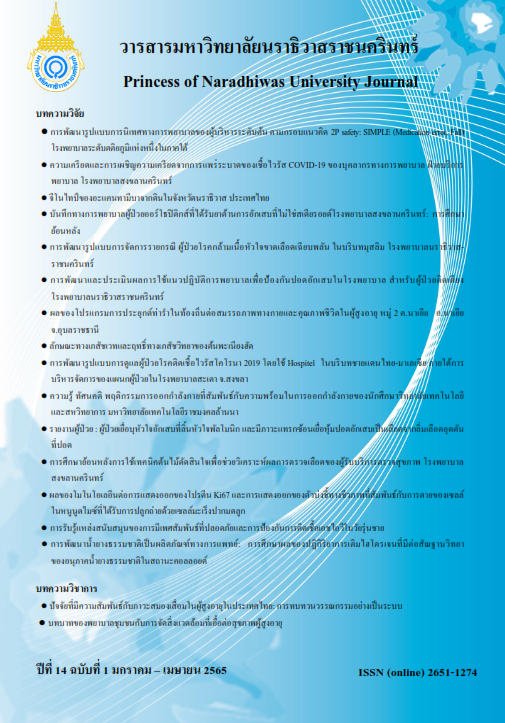The Natural Rubber Latex Development as Medical Device Products: the Effect Study of H2-added Reaction on the Morphology of Natural Rubber Latex Particles in the Colloid State
Keywords:
H2-added reaction, Morphology, Cis-trans isomerization, Natural rubber latex particles, Raman spectroscopyAbstract
A study of H2-added reaction or hydrogenation of natural rubber helps to improve the original natural rubber properties such as thermal stability, ozone resistance, radiation-induced degradation, and chemical resistance due to the unsaturated (C=C) bonds decreased and it can be applied to develop as medical device products. This work focused on the effect study of H2-added reaction on the morphology of natural rubber latex particles in the colloid state. The morphology of natural rubber latex particles was carried out on transmission electron microscopy and the chemical structure was confirmed by using 1H-NMR, Raman, and FT-IR spectra. In this study, it was found that natural rubber latex particles without H2-added reaction showed that the surface and shape of natural rubber latex particles were similar to original natural rubber latex particles. In contrast, the H2-added reaction on the surface of natural rubber latex particles was presented that natural rubber latex particles were changed into a square or edge shape. However, the particle sizes of natural rubber latex and H2-added natural rubber latex were similar by using a particle size analyzer. Thus, the H2-added reaction was affected on the morphology of natural rubber latex particles and it indicated the H2-added and Cis-trans isomerization takes place. Moreover, natural rubber latex via H2-added reaction can be used and applied to develop medical device products with latex in future work.
References
Bunce, S.J., Edwards, H.G.M., Johnson, A.F., Lewis, I.R., & Turner, P.H. (1993). Synthetic polyisoprenes studied by Fourier transform Raman spectroscopy. Spectrochimica Acta, 49, 775-783.
Daniel, L., Reger, S.R., & Goode, D.W.B. (2010). Chemistry: principles and practice, (3rd ed). Cengage, Boston.
De Sarkar, M., De, P.P., & Bhowmick, A.K. (2000). Diimide reduction of carboxylated styrene–butadiene rubber in latex stage. Polymer, 41, 907-915.
German, R.M., Suri, P., & Park, S.J. (2009). Review: liquid phase sintering. Journal of Materials Science, 44, 1-39.
Ha, N.T., Kaneda, K., Naitoh, Y., Fukuhara, L., Kosugi, K., & Kawahara, S. (2015). Preparation and graft-copolymerization of hydrogenated natural rubber in latex stage. Journal of Applied Polymer Science, 132, 42435.
Healey, A.M., Hendra, P.J., & West, Y.D. (1996). A Fourier-transform Raman study of the strain-induced crystallization and cold crystallization of natural rubber. Polymer, 30, 4009-4024.
Hendra, P.J., & Jackson, K.D. (1994). Applications of Raman spectroscopy to the analysis of natural rubber. Spectrochimica Acta, 50, 1987-1997.
Hinchiranan, N., Lertweerasirikun, W., Poonsawad, W., Rempel, G.L., & Prasassarakich, P. (2008). Cure characteristics and mechanical properties of hydrogenated natural rubber/natural rubber blends. Journal of Applied Polymer Science, 111, 2813-2821.
Hinchiranan, N., Lertweerasirikun, W., Poonsawad, W., Rempel, G.L., & Prasassarakich, P. (2009). Hydrogenated natural rubber blends: aspect on thermal stability and oxidative behavior.
Hirata, Y., Hara, A., & Aksay, I.A. (2009). Thermodynamics of densification of powder compact. Ceramics International, 35, 2667-2674.
Jackson, K.D. Loadman, M.J. Jones, C.H., & Ellis, G. (1990). Fourier transform Raman spectroscopy of elastomers: an overview. Spectrochimica Acta, 46, 217-226.
Jamaluddin, N., Yusof, M.J. Abdullah, I., & Yusoff, S.F. (2016). Synthesis, characterization, and properties of hydrogenated liquid natural rubber. Rubber Chemistry and Technology, 89(2), 227-239.
Ji, M., Yue, D., Wu, X., Zhao, S., Sun, S., & Zhang, L. (2017). Structure and performance of hydrogenated natural rubber prepared by the latex method. Plastics, Rubber and Composites, 46(6), 245-250. Journal of Applied Polymer Science, 113, 1566-1575.
Kohjiya, S., & Ikeda, Y. (2014). Chemistry, manufacture and applications of natural rubber; Elsevier, London.
Kongparakul, S., Flora, T.T. ,& Rempel, G.L. (2011). Metathesis hydrogenation of natural rubber latex. Applied Catalysis A: General, 405, 129-136.
Mahittikul, A., Prasassarakich, P., & Rempel, G.L. (2006). Hydrogenation of natural rubber latex in the presence of OsHCl(CO)(O2)(PCy3)2. Journal of Applied Polymer Science, 100, 640-655.
Mahittikul, A., Prasassarakich, P., & Rempel, G.L. (2007(a)). Diimide hydrogenation of natural rubber latex. Journal of Applied Polymer Science, 105, 1188-1199.
Mahittikul, A., Prasassarakich, P., & Rempel, G.L. (2007(b)). Noncatalytic hydrogenation of natural rubber latex. Journal of Applied Polymer Science, 103, 2885-2895.
Parhami, F., McMeeking, R.M., Cocks, A.C., & Suo, Z. (1999). A model for the sintering and coarsening of rows of spherical particles. Mechanics of Materials, 31, 43-61.
Petrukhina, N.N., Golubeva, M.A., & Maksimov, A.L. (2019). Synthesis and use of hydrogenated polymers. Russian Journal of Applied Chemistry, 92(6), 715-733.
Piya-areetham, P., Prasassarakich, P., & Rempel, G.L. (2013). Organic solvent-free hydrogenation of natural rubber latex and synthetic polyisoprene emulsion catalyzed by water-soluble rhodium complexes. Journal of Molecular Catalysis A: Chemical, 372, 151-159.
Piya-areetham, P., Rempel, G.L., & Prasassarakich, P. (2014). Hydrogenated nanosized polyisoprene as a thermal and ozone stabilizer for natural rubber blends. Polymer Degradation and Stability, 102, 112-121.
Saengdee, L., Phinyocheep, P., & Daniel, P. (2020). Chemical modification of natural rubber in latex stage for improved thermal, oil, ozone and mechanical properties. Journal of Polymer Research, 27, 275-288.
Samran, J. (2005). A study of Non-Catalytic Hydrogenation of Natural Rubber; Mahidol University, Bangkok. (in Thai).
Samran, J., Phinyocheep, P., Daniel, P., Derouet, D., & Buzare, J. Y. (2004)(a). Spectroscopic study of di-imide hydrogenation of natural rubber. Macromolecular Symposia, 216, 131-143.
Samran, J., Phinyocheep, P., Daniel, P., Derouet, D., & Buzare, J.Y. (2004(b)). Raman spectroscopic study of non-catalytic hydrogenation of unsaturated rubbers. Journal of Raman Spectroscopy, 35, 1073-1080.
Simma, K., Rempel, G.L., & Prasassarakich, P. (2009). Improving thermal and ozone stability of skim natural rubber by diimide reduction. Polymer Degradation and Stability, 94, 1914-1923.
Additional Files
Published
How to Cite
Issue
Section
License
Copyright (c) 2022 Princess of Naradhiwas University Journal

This work is licensed under a Creative Commons Attribution-NonCommercial-NoDerivatives 4.0 International License.




